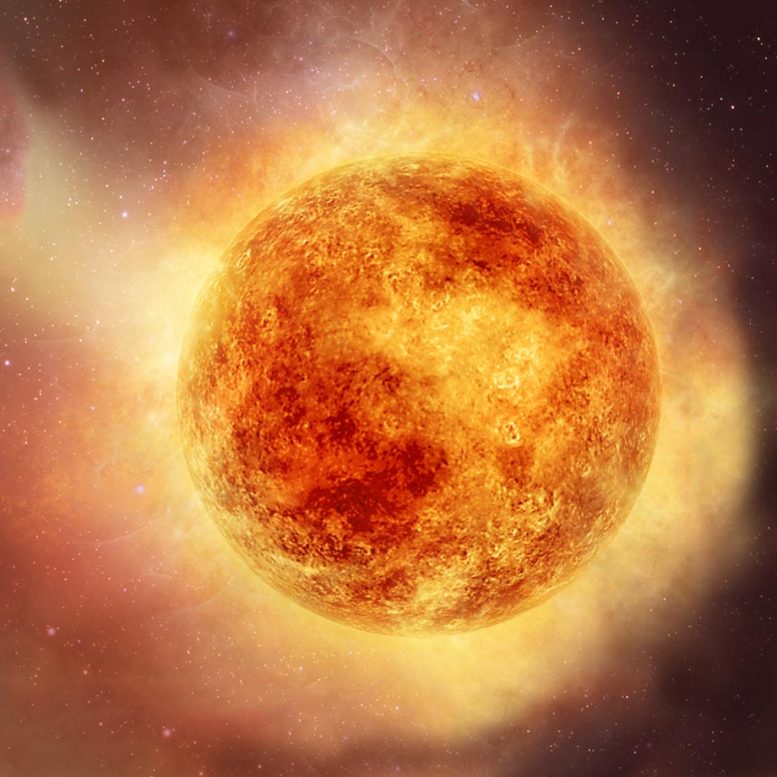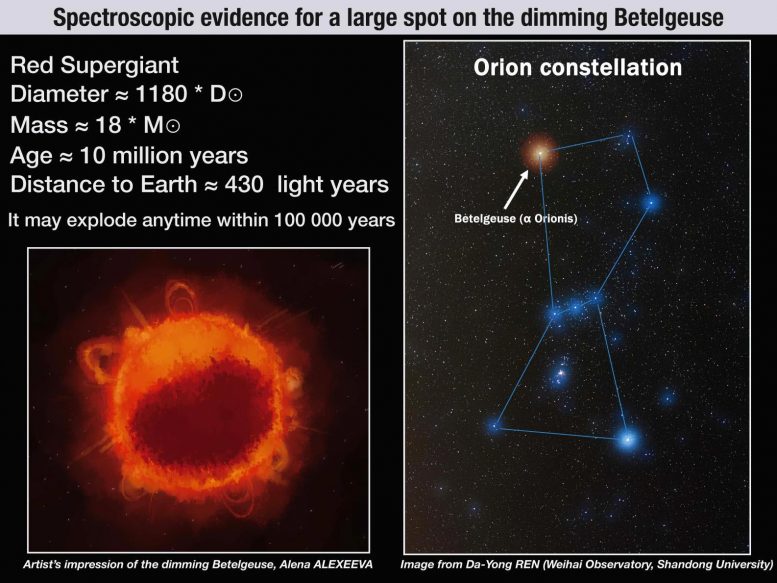
Betelgeuse (α Orionis) is the bright reddish star located in the shoulder of the Orion constellation and can be seen by the naked eye in the night sky.
From October 2019 to March 2020, Betelgeuse demonstrated a mysterious dimming, capturing the attention and imagination of both astronomers and the public. While being a variable star that exhibits periodic and sometimes irregular light change, this dimming is the most significant observed in the last 50 years. It became fainter by more than 2.5 times, which even can be noticed by the naked eye in the night sky. Several scenarios have been put forward by astronomers around the world: pre-phase of supernova explosion, obscuring dust, or changes in the photosphere of the star.
New Study Sheds Light on the Dimming
A new study led by Prof. ZHAO Gang from the National Astronomical Observatories of Chinese Academy of Sciences (NAOC) sheds light on the nature of the mysterious dimming of Betelgeuse. Scientists from Shandong University and the University of Missouri (USA) also joined this study.
The study was published in Nature Communications today (August 5, 2021).

Scientists determined that Betelgeuse’s dramatic dimming was due to a 170 K temperature drop, likely caused by a giant star-spot.
Betelgeuse is the brightest star in the night sky in the near-infrared wavelength range. This is the most suitable wavelength range for investigating red supergiants like Betelgeuse.
The research team investigated the high-resolution near-infrared spectra of Betelgeuse obtained at Weihai Observatory of Shandong University on January 31, March 19, April 4, and April 6, 2020, covering the dimming and post-dimming phases. “Taking our advantage in spectroscopic analysis, we aim to understand the possible cause of the mysterious dimming of Betelgeuse,” said Prof. ZHAO Gang, the corresponding author of this study.
To this end, the team developed a special technique for determining the effective temperatures of red supergiants.
“Our method is based on the measurement of titanium oxide (TiO) and cyanide (CN) molecular lines in stellar spectra. The cooler a star is, the more these molecules can form and survive in its atmosphere and the molecular lines are stronger in the stellar spectrum. In a hotter atmosphere, these molecules dissociate easily and do not survive,” said Dr. Sofya Alexeeva, the first author of this study.
Temperature Variations Linked to Dimming
“We have found that at the minimum of its luminosity, the effective temperature of Betelgeuse on January 31, 2020, was 3476 Kelvin. However, after it recovered its brightness, on April 6, 2020, the effective temperature was 3646 Kelvin. The changing of the effective temperature by 170 K is sufficient to explain this mysterious dimming,” said Dr. Sofya Alexeeva.
What could lead to a temperature drop by 170 K? It could be caused by a large dark star-spot on the surface of Betelgeuse. The presence of spots on red supergiants is a well-known phenomenon. These spots are likely a consequence of convective flows or cool convective cells, which are widely believed to be present in such stars.
“Our findings offer insight into the nature of red supergiant stars, the main contributors to the enrichment of heavy elements in the Universe,” said Prof. ZHAO Gang.
Reference: “Spectroscopic evidence for a large spot on the dimming Betelgeuse” by Sofya Alexeeva, Gang Zhao, Dong-Yang Gao, Junju Du, Aigen Li, Kai Li and Shaoming Hu, 5 August 2021, Nature Communications.
DOI: 10.1038/s41467-021-25018-3
Never miss a breakthrough: Join the SciTechDaily newsletter.